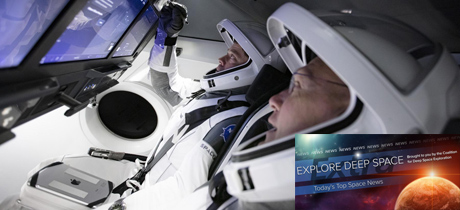In Today’s Deep Space Extra… More astronauts could be launching to the International Space Station (ISS) in late May as part of NASA’s Commercial Crew Program.
Human Space Exploration
Bridenstine says Crew Dragon could launch with astronauts at end of May
Coalition Members in the News – Boeing, United Launch Alliance
Spaceflightnow.com (4/13): NASA Administrator Jim Bridenstine offered the end of May/early June launch time frame in an interview. SpaceX’s Crew Dragon Demo-2 test flight is to send two NASA astronauts, Doug Hurley and Bob Benken, to the ISS, perhaps for an extended stay that would bolster the number of astronauts and cosmonauts living and working on the orbiting science lab from three, including only one U.S. astronaut, to five altogether. The launch schedule depends on positive results from the testing of Dragon’s landing parachutes and avoiding exposure to the coronavirus. The test is to certify Dragon for regularly scheduled transportation of crews to the Space Station under NASA’s Commercial Crew Program.
Here’s an unprecedented look at Apollo 13’s damaged service module
Arstechnica.com (4/13): Newly processed imagery from NASA’s Apollo 13 mission helps to chronicle the near tragic mission that unfolded 50 years ago this week. Commander Jim Lovell, command module pilot John Swigert and lunar module pilot Fred Haise were to become the third Apollo mission to orbit the Moon so that Lovell and Haise could land. As they approached the Moon, the oxygen tank on their spacecraft exploded. They managed to loop around the Moon and return to Earth safely with a splashdown thanks to their teamwork and an intense, around the clock effort by Mission Control in Houston.
Space Science
Planning the next decade of planetary science missions
The Space Review (4/13): The planetary science community is at work on a new 10 year long road map, known formally as the “Planetary Science and Astrobiology Decadal Survey 2023-2032,” despite a disruptive start due to the coronavirus pandemic. The outbreak led to cancellation of last month’s annual Lunar and Planetary Science Conference in the Houston suburb of The Woodlands, where the road map was to be discussed. Nonetheless, follow-up virtual meetings make it clear that astrobiology and planetary defense are emerging themes. Congress holds the successive “decadals” organized by the National Academies of Sciences in high regard as they set policy and budgets.
Intuitive Machines sets lunar landing date as Moon plans progress
Spacepolicyonline.com (4/14): Houston based Intuitive Machines has picked October 2021 as the target launch date and Vallis Schröteri, a Grand Canyon like valley on the Moon, as the landing site for the company’s first Nova-C lander mission. The lander will carry five NASA selected science and technology payloads under the agency’s Commercial Lunar Payload Services initiative. Among the NASA payloads is an automated precision landing system designed to identify and steer the lander away from boulders and other surface hazards during touchdown. The mission is intended to help advance NASA’s plans for an accelerated return to the surface of the Moon with human explorers in 2024.
Oumuamua origin story: How our mysterious interstellar visitor may have been born
Space.com (4/13): This large mysterious object was spotted moving through the solar system in October 2017, prompting theories about its extra solar origins. A new study, published in the journal Nature Astronomy, suggests Oumuamua is an elongated fragment from a planet or planetary body of some kind that was torn away by gravity as the object passed close to its host star.
Astronomers spot brightest supernova ever observed
Coalition Member in the News – Northrop Grumman
Futurism.com (4/13): Some 500 times brighter than normal, the brightest stellar explosion observed so far unfolded perhaps after two large stars merged, each much larger than the sun, and 3.6 billion miles away. There may be more of the same, and the NASA led James Webb Space Telescope (JWST), awaiting launch in March 2021, may provide the means for future observations.
Op Eds
U.S. should think about the space economy as a single entity
SpaceNews.com (4/13): As the space industry emerges from a setback linked to the coronavirus pandemic, it needs to better consolidate government and commercial as well as small and large space system. At the same time, it must acknowledging the risk that comes with innovation and capabilities acquisition and a space economy that could be a risk of saturation by China, writes Joshua Huminski, director of the national security space program at the Center for the Study of the Presidency & Congress, in an op-ed.
The role of global cooperation in space after COVID-19
The Space Review (4/13): Looking ahead, it’s likely the coronavirus pandemic will take a global economic toll, one that could have policymakers questioning expenditures for space exploration. It’s an outcome that could constructively prompt more cooperation globally on the missions of greatest benefit to all humankind, writes Ajey Lele, senior fellow at the Institute for Defence Studies and Analyses, a New Delhi-based security think tank.

